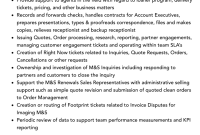Role Of Training And Development – Employee training is designed to train the workforce on specific knowledge and skills to improve job performance. It also prepares individuals for career advancement through leadership development training.
Skill shortages, inflation and talent churn have made companies realize they need to upskill their workforce, and L&D has never been in a better position to help. In LinkedIn’s new Workplace Learning report, 89% of L&D professionals agree that proactively building employee skills will help drive the future of workplace development.
Role Of Training And Development
What is employee training? Benefits of employee training Employee training methods 7 steps to developing an employee training program
Introduction To Employee Training And Development Chapter 1
Effective training programs can have a positive impact on employee performance. First, it improves productivity and efficiency. Training programs teach effective work techniques, proper use of tools and software, and good time management practices. Employees become smarter and more efficient and can get things done faster and produce more. In addition, effective research and development programs train employees to understand and follow industry standards, while promoting consistency and quality in work.
As productivity and quality increase, so does profitability. The Association for Talent Development (ATD) revealed that companies that offer a formal training program increase their profit per employee by 218 percent. They also found that these companies had 24% higher profit margins than others that spent less on training.
Download your free step-by-step guide to identify the skills your employees need to thrive now and in the future.
Here are the steps for HR when developing an employee training program: 1. Conduct a needs assessment and training analysis.
Role Of Employee Training From Onboarding To Promotion
Human resources conducts performance appraisals for employees, which involves evaluating people’s performance and skills against the expectations of their roles and responsibilities. HR compares the targeted skills and abilities for each position with the actual skills of the employees. This comparison helps identify skill gaps or areas where employees may need further development to meet their job requirements or improve their performance. 2. Set clear training goals
HR must collaborate with managers to develop clear objectives to understand current and future business goals. From there, they should define the learning outcomes of the training programs that align with the company’s priorities. Aligning training initiatives with company goals helps ensure training programs contribute to the overall success of the organization. 3. Design customized training programs
Alignment of educational content and curriculum with stated learning objectives, along with consideration of key issues, ensures that the educational program will be purposeful, effective and relevant. Introducing core topics, concepts and skills ensures that training is focused on the most critical areas. It also increases the potential for participants to acquire targeted skills and apply them in their roles. 4. Incorporate blended learning approaches
Determine the most appropriate teaching methods for teaching instruction. Methods can include presentations, hands-on activities, group discussions, role plays, case studies, videos, online modules, or a combination of these approaches. The choice of teaching methods should match the learning objectives and match the preferred learning styles of the participants.
Continuing Professional Development Of Teachers
Using technology to deliver training can improve the effectiveness, accessibility and flexibility of training programs such as LMS (learning management system), virtual conferencing tools, multimedia presentations, //VR simulations, mobile apps and e-learning modules. 6. Implement the training program
Creating a training program and scheduling involves planning and organizing the sequence of training activities and allocating time for each task. Here are the steps:
Continuous follow-up and feedback after training is critical to reinforce the application and retention of new skills acquired. employee training systems
Training systems can vary in specificity, focus and integration with HR and other organizational systems. Organizations often choose systems that best meet their training goals, resources, and overall HR strategies. Below is an overview of employee training systems:
What Is Learning And Development (l&d)? Your Guide
A software platform that provides, manages and tracks employee training programs. It usually includes course creation, content management and assessment tracking features.
An online platform that provides a virtual space for education, communication, collaboration and content exchange. It usually includes features such as discussion forums, multimedia content and reviews.
A digital platform that offers personalized learning experiences, content customization and social learning capabilities. It focuses on student engagement, knowledge sharing and continuous learning.
A comprehensive platform covering various HR functions, including employee training. It facilitates employee development, performance management, career planning and succession planning.
The Importance Of Training Employees: 11 Benefits
A system used to create, manage, and deliver educational content, including documents, videos, presentations, and other learning materials. It handles content organization, version control and access control.
A platform that applies game design elements and mechanics to educational programs to improve engagement, motivation and learning outcomes. It usually includes features such as leaderboards, badges and rewards.
A platform that promotes collaborative learning and knowledge sharing among employees. It enables discussions, content sharing, peer-to-peer learning and networking within the organization.
A platform designed to deliver educational content on mobile devices. It allows employees to access training materials anytime, anywhere and often includes features such as micro-learning modules and offline access.
Infographic: 2014 Training Trends & Hr’s Role In The Training Process
A system used to assess the knowledge, skills and abilities of employees. This may include tools for creating quizzes, tests, surveys and performance evaluations. This helps measure the effectiveness of the training and identify areas for improvement.
Various communication and collaboration tools such as video conferencing platforms, chat applications and project management software enable real-time communication, teamwork and knowledge sharing between employees.
You can use a variety of training evaluation metrics to measure the effectiveness of employee training so you know if you’re meeting your training goals and getting a return on your investment. These include the cost of employee training and the ROI of training.
Collecting and analyzing training data is important in making transactional decisions. Here are some tips to help HR professionals collect and analyze data:
The Llpa Shares The Value Of Microsoft Certification And Training
Organizations that want to increase the potential of their employees must prioritize employee training. By designing and implementing effective training programs, HR professionals can equip employees with the knowledge and skills to do their jobs properly.
Map your career in HR. Try our needs tool to determine the path you want to take based on your HR career goals and skills.
A well-designed employee training program improves employee engagement, reduces employee retention, and addresses skills gaps. When HR professionals work to deliver training programs that are aligned with business goals, they are building the foundation for the organization’s long-term success.
Future-proof your HR career by continuously expanding your skills with the latest and relevant HR skills. Learning: acquisition of knowledge, skills, abilities, attitudes or behavior Human capital: means: knowledge (know what) advanced skills (know how) system understanding and creativity (know why) motivation to provide quality products and services (caring why)
Training & Development Manager Job Description
Training: Assists in learning work-related skills, knowledge, abilities, or behaviors. the company
Informal learning Self-directed learning occurs without a coach or teacher Is driven by the goal of development Does not take place within formal learning Breadth, depth, and time are controlled by the employee Explicit knowledge is well documented, easily expressed, and easily transferred from person to person. person
The main link of formal education and the development of tacit knowledge Personal knowledge based on personal experiences that are difficult to codify The result of informal learning Knowledge management The process of improving company performance through design and implementation: tools, processes, systems, structures and culture. to improve the creation, sharing and use of knowledge
The Instructional Design Process A structured approach to developing training programs based on the principles of Instructional System Design (ISD) is the ADDIE model – Analysis, design, development, implementation and evaluation should be systematic but flexible to meet business needs.
The Role Of Non Technical Training In Professional Development
1. Carrying out needs assessment of organizational analysis, task analysis, personal analysis 2. Ensuring the readiness of employees for attitude and motivational training, basic skills 3. Creating a learning environment, learning objectives, practice, meaningful material, learning community feedback, managing a modeling program, managing partners and managers 4. Ensure the transfer of the training program, analysis of costs Benefits Choose an evaluation design Identify the learning outcomes 5. Develop an evaluation plan Traditional online learning 6. Choose a training method Make changes to improve the evaluation of the program implementation 7. Monitoring and evaluation of the program
Disadvantages of the ISD model are rarely practiced in real-life organizations The mandatory requirement of trainers increases the time and cost of developing a training program A final point: evaluation may lead to the assumption that training is the best solution.
Economic trends Globalization Increased value of intangible assets and human capital Focus on linkage to business strategy Demographic change and workforce diversity Skilled management Customer service and emphasis on new technology quality High performance work systems
11 Globalization Offshoring: The process of moving jobs from the United States to other parts of the world Advantages – lower labor costs Disadvantages Low health and safety standards Lack of skills needed to perform the job
Training & Development Specialist Job Description
Human Capital • Tacit Knowledge • Education • Job-Related Knowledge • Job Communication Skills Customer Capital • Customer Relationships • Branding • Customer Loyalty • Distribution Channels Social Capital • Organizational Culture • Management Philosophy • Management Practices • Informal Network Systems • Collaborative Capital/Intellectual Leadership • Patents • Copyrights • Trade Secrets • Intellectual Property
Human capital: employee characteristics, life experiences, knowledge, intelligence, energy and enthusiasm Intellectual capital: planned knowledge available in society Social capital: relationships in society.
Customer Equity: Value
Role of youth in development, role of product development, role of business development manager, role of technology in training and development, the role of training and development, role and responsibility of business development manager, role of organizational development, role of organisational development, business development role and responsibilities, training and development role, role of business development, role of hr in training and development


